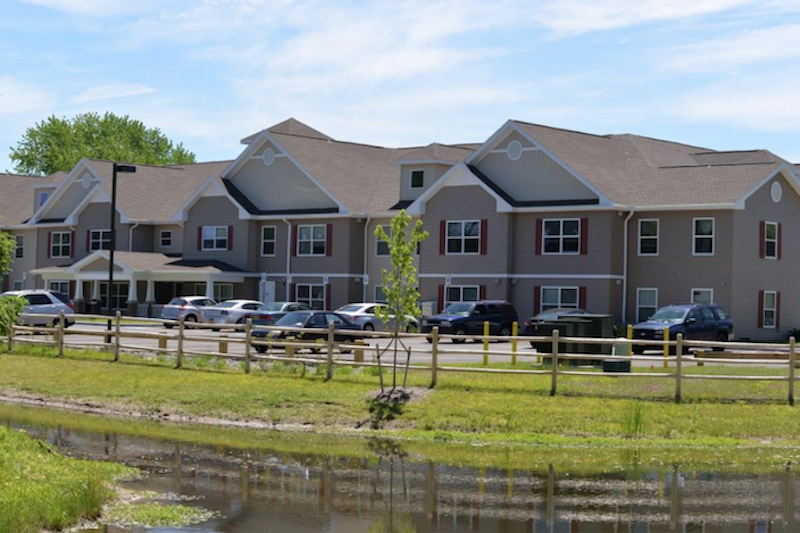Long Pond Senior Housing, a building that combined the New York State Homes and Community Renewal (NYSHCR) 9% tax credit program and the Department of Health’s (DOH) licensed Enriched Housing Program for frail seniors was the first of its kind in New York State.
The project, which achieved LEED Gold certification, was designed to comply with the Governor’s Medicaid Redesign Team (MRT), a program intended to achieve measurable improvement in health outcomes, sustainable cost control, and a more efficient administrative structure. The project reduced wood waste by using panelized off-site construction.
The Rochester, N.Y.-area project averaged a Home Energy Rating System (HERS) Score of 51, roughly a 49% energy reduction compared to a home built to code. High efficiency central hot water boilers, furnaces and air conditioning; advanced air sealing strategies; energy efficient lighting and appliances; and upgraded insulation resulted in high-energy performance.
The building team had to use NYSHCR’s design standards and fit 54 units into 53,000 sf within a per-square-foot budget, and convert 25% of the building’s space into a shared common area, constrained by living and dining space minimums.
Related Stories
| Oct 15, 2014
Harvard launches ‘design-centric’ center for green buildings and cities
The impetus behind Harvard's Center for Green Buildings and Cities is what the design school’s dean, Mohsen Mostafavi, describes as a “rapidly urbanizing global economy,” in which cities are building new structures “on a massive scale.”
| Oct 12, 2014
AIA 2030 commitment: Five years on, are we any closer to net-zero?
This year marks the fifth anniversary of the American Institute of Architects’ effort to have architecture firms voluntarily pledge net-zero energy design for all their buildings by 2030.
| Sep 24, 2014
Architecture billings see continued strength, led by institutional sector
On the heels of recording its strongest pace of growth since 2007, there continues to be an increasing level of demand for design services signaled in the latest Architecture Billings Index.
| Sep 22, 2014
4 keys to effective post-occupancy evaluations
Perkins+Will's Janice Barnes covers the four steps that designers should take to create POEs that provide design direction and measure design effectiveness.
| Sep 22, 2014
Sound selections: 12 great choices for ceilings and acoustical walls
From metal mesh panels to concealed-suspension ceilings, here's our roundup of the latest acoustical ceiling and wall products.
| Sep 9, 2014
Using Facebook to transform workplace design
As part of our ongoing studies of how building design influences human behavior in today’s social media-driven world, HOK’s workplace strategists had an idea: Leverage the power of social media to collect data about how people feel about their workplaces and the type of spaces they need to succeed.
| Sep 7, 2014
Behind the scenes of integrated project delivery — successful tools and applications
The underlying variables and tools used to manage collaboration between teams is ultimately the driving for success with IPD, writes CBRE Healthcare's Megan Donham.
| Sep 3, 2014
New designation launched to streamline LEED review process
The LEED Proven Provider designation is designed to minimize the need for additional work during the project review process.
| Sep 2, 2014
Ranked: Top green building sector AEC firms [2014 Giants 300 Report]
AECOM, Gensler, and Turner top BD+C's rankings of the nation's largest green design and construction firms.
| Sep 2, 2014
Harvard study: Nation unprepared to meet housing needs of aging population
The number of adults in the U.S. aged 50 and over is expected to grow to 132 million by 2030. But housing that is affordable, physically accessible, well-located, and coordinated with supports and services is in too short supply.
















